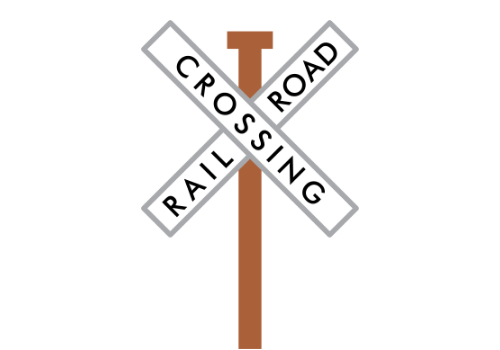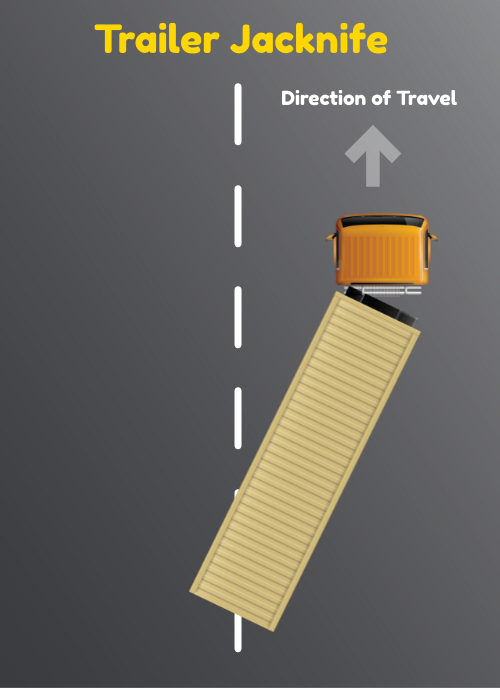Combination Vehicles Test Study Guide for the CDL
Page 1
General Information
Most people taking the CDL exam will drive a combination vehicle regularly. This study guide gives a brief overview of the most important information needed to drive combination vehicles.
A combination vehicle is the combining of a tractor unit with one or more trailers. This is commonly called a “semi” or “semi truck.” The tractor is connected to the trailer(s) with a fifth-wheel and/or a converter dolly.
The fifth wheel allows the combination vehicle to bend in the middle. This complicates set up, driving, dashboard controls, braking, and backing.
Major Safety Concerns
All commercial vehicles require care to operate safely. Operating a combination vehicle is more complicated than operating a straight truck. While all procedures that promote driving safety are important, there are several areas of concern that are unique to combination vehicles. You’ll want to know and follow the safest methods while driving.
Rollover Risk
The risk of rollover greatly increases when driving a combination vehicle. To help decrease the risk:
- Always keep cargo as close as possible to the ground.
- Use gentle steering. This is essential because of the “crack-the-whip” effect that happens when vehicles pull trailers.
Quick lane changes cause rearward amplification:
- This can overturn the trailer even without overturning the tractor.
- The rearmost trailer is the most likely to roll over.

Retrieved from: https://www.dmv.ca.gov/imageserver/dmv/images/pubs/cdl/comlhdbk_img_83.jpg
Braking
Empty trucks take much longer to stop than those that are fully loaded and are at a greater risk of jackknifing. Bobtails (tractors with no trailers attached) take even longer to stop. Trucks with lightly loaded suspension systems have poor traction and are more prone to lock up the wheels and/or jackknife.
Large vehicles take longer to stop than smaller vehicles. Always brake early when driving a combination vehicle. Stay aware of your surroundings. Avoid panic stops. To avoid jackknifing, try to be cognizant of what you see in your mirrors. Seeing your trailer in your mirrors is a clear sign that it is skidding. If this occurs, release the brakes immediately and try to regain control of your vehicle.
Railroad Tracks
Railroad tracks can cause problems for combination vehicles, especially when pulling trailers with low clearance underneath.
- Never stop any vehicle on railroad tracks.
- Never shift gears while crossing railroad tracks.
Equipment that is especially prone to getting stuck on raised railroad tracks:
- lowboy trailers
- car carriers
- moving vans
- possum-belly livestock trailers
- single axle tractors pulling long trailers (especially if the trailer’s landing gear is arranged for a double axle tractor)
If your truck gets stuck on railroad tracks, get out of the vehicle and move away from the tracks. Contact help.
Note: The information below probably won’t be on your written DMV test, but it is important information to know about railroad safety.
Most public railroad crossings are marked with a DOT placard. DOT placards are usually blue with white lettering. The placards have an (800) number to call and a unique DOT crossing number. This DOT crossing number is the best way for the railroad to identify a specific crossing. There may also be street name information, city name, or other information. Call the (800) number and read the information from the placard. If you can’t find a DOT placard [or the correct (800) number], call 911.
DOT placards are prominently located near crossings. DOT placards might be attached to:
- a nearby railroad equipment shack
- the crossing mechanism
- the crossing arm
- a crossbuck pole (two X-shaped signs, with the words “Railroad” and “Crossing”)
Do not delay. Contact help as soon as possible.

Skids
When the wheels of a trailer lock up, the trailer will tend to swing around. The trailer could enter another lane and eventually jackknife the entire truck. This is especially prone to happen when the trailer is light or unloaded.
Recovering from a trailer skid:
- Recognize the skid. Whenever you brake strongly, check your mirrors.
- Get off the brakes. Release the brakes to recover wheel traction.
When the wheels grip again, the trailer will start following the tractor again. Resume braking.
Do not use the trolly bar (trailer hand brake). Trailer brakes caused the skid—releasing the brakes will fix the problem.

Turn Wide
When a vehicle travels in a straight line, all the wheels follow the steering wheels. When a vehicle goes around a corner, the rear wheels follow a different path. Each wheel takes a “shortcut.” This “shortcut” is called off-tracking (or, “cheating”). The last wheels off-track the most. Long trailers will off-track more than short trailers.

Retrieved from: https://www.dmv.ca.gov/portal/dmv/detail/pubs/cdl_htm/sec6
Steer the front wheels wide enough that the last, inside wheel will clear the curb and other obstructions. However, don’t swing so wide that you leave a gap between your trailer and the curb. You don’t want other drivers passing you on the right, or getting between the rear of your trailer and the curb.
If you can’t complete the turn from completely inside your own lane, turn wide as you complete the turn (button hook) not before you start the turn (jug handle).
Hint: You might see this on your DMV written test: You want to steer wide as you complete the turn.

Retrieved from: https://www.dmv.ca.gov/portal/dmv/detail/pubs/cdl_htm/sec6
Backing Up
Backing a combination vehicle can be especially tricky. To back up safely, always look at your path and back slowly using both mirrors. If possible, get a helper to guide you as you back. If you see the trailer veering off path, correct it immediately by turning the wheel or pulling forward.
If possible, back in a straight line. If you need to “curve back,” curve on the driver’s side. It is much easier to see on the driver’s side, than the passenger’s side. (Hint: These facts might be on your written DMV test.)
It is easier to see using the mirrors on the driver’s side than the mirrors on the passenger side. Also, roll down the driver’s window, and look over your shoulder. Stick your head out the window if it helps. It is better to get snowed on than to back into something.
Remember: G.O.A.L.: “Get Out And Look”. Even veteran drivers climb out of the cab. Look behind the trailer and around the corner. Locate what cannot be seen in the mirrors. Get out multiple times, if necessary.
Note: You won’t see the following bits of advice on the written DMV test, but this is good advice for when you are driving professionally.
-
Many times, when you are in a busy yard, backing up to a door, there will be a lot of other drivers waiting for you to get out of their way. Don’t hurry. Remain calm. G.O.A.L. Back your truck safely. Every experienced driver was a new driver at one point. They would rather wait a few minutes than have you back into something.
-
While you are midway in your backing attempt—if you find that your truck is “in the hole” but not actually lined up with the door—your truck will be out of everyone’s way. Don’t pull up right away. Let all the other drivers pass. After the other trucks have moved on, then pull forward (to make a better run at the door). You will find it much easier to back up to the door, without half a dozen other drivers watching you.
Note: You won’t see the following bit of information on the written DMV test.
Backing a trailer is difficult. In truck driving school, you will spend about half your driving time:
- backing a trailer
- shifting a manual, non-synchronized gearbox
All Study Guides for the CDL are now available as downloadable PDFs